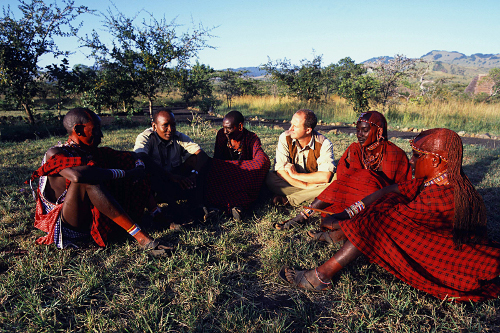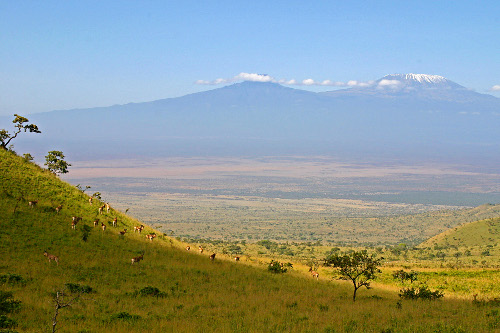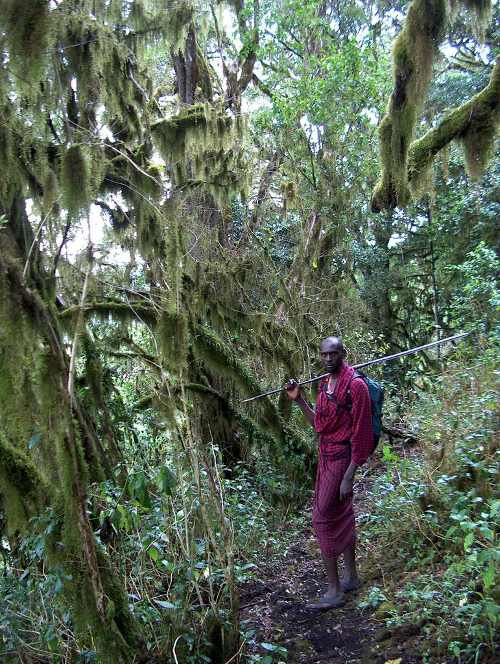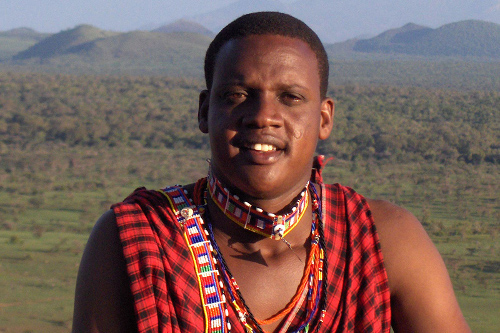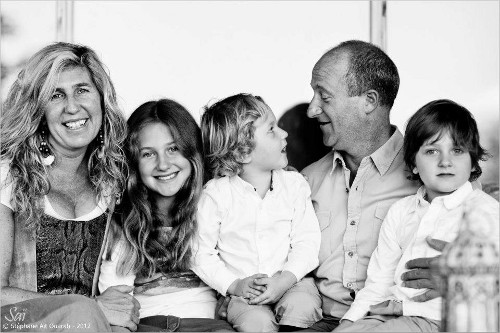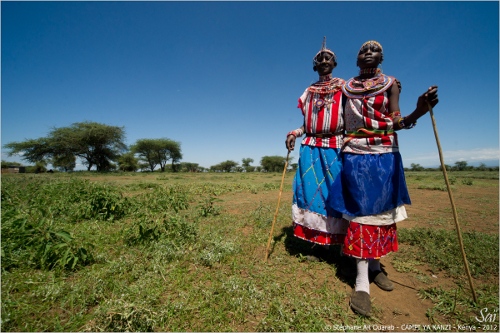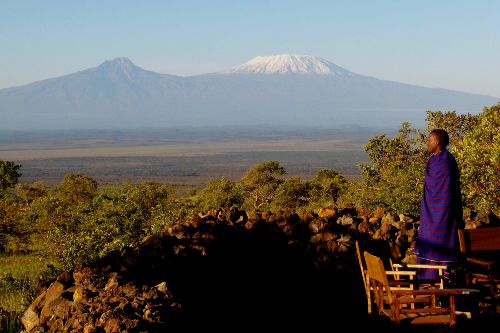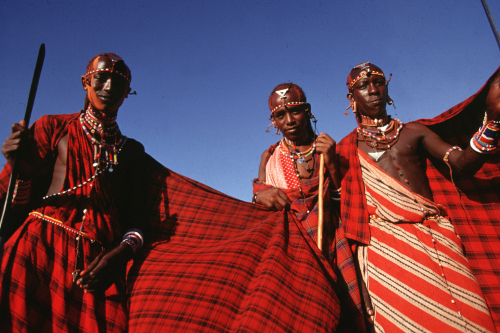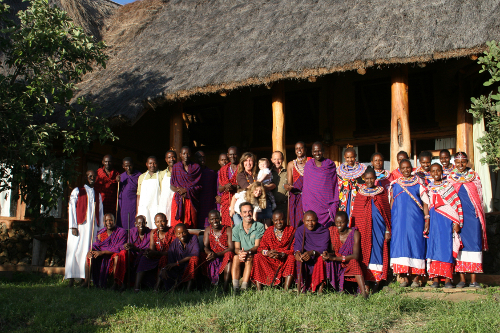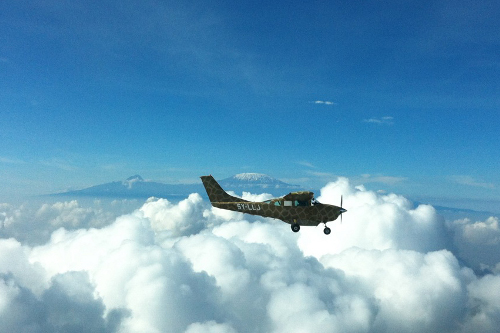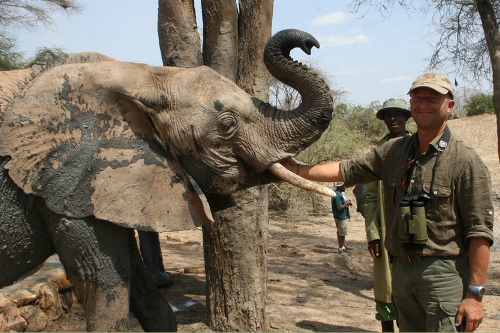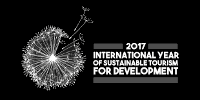Luca Belpietro is an Earth Changer.
If growing up means giving up your passions that as adults are drummed out of us, Luca doesn’t want to grow up, but retain a child-like belief in dreams - in his case to live and work in Kenya with a Maasai community to support sustainable culture, conservation and livelihoods, a dream come true with ecolodge Campi ya Kanzi and the Maasai Wilderness Conservation Trust of which it forms part.
Places
I was born in Italy, to a mother and father who had a passion for Africa, and who would go on safari every year. Desperate to accompany my father at the age of 4, I slept in a tent in our vineyard with my dogs to prove my dedication to the cause. The first safari with him to Kenya in 1975 aged 11 was really a milestone in my life. It wasn’t just a dream, it was a passion. Already at that age I told my parents it was where I wanted to be, and the Maasai village we visited ended up being where I am living, working and engaging with, and for, the same community. Those nights didn’t allow me to go back to ‘normality’.
If you feel something is driving you, you shouldn’t listen to the ‘grown-up’ who tells you ‘stop dreaming'.
I didn’t stop dreaming, I dared to proceed. And that desire to follow my passion eventually led me to move to Kenya, and has led to something much bigger than myself, impacting the lives of many. To me, it’s testament to the fact that if you follow your passions, things unfold for you. You make it the way you desire.
But it took time. We had friends who were farmers on Lake Naivasha, in Kenya, I spent months with them after high school, then in my university research, struck by the strong conflict between protected areas and communities, I wrote a thesis on “Sustainable Development and Environment Conservation: Wildlife as a Natural Resource in Kenya”, seeding the concept for a new model for conservation. I gained a degree in economics, and after had a career as the managing director of a financial consulting firm, although of course my interest meant I stayed involved in wildlife conservation in Kenya.
It wasn’t until 1995 that I left the world of finance, followed my heart to Kenya, and settled in the Maasai-owned Chyulu Hills in the world-famous Amboseli-Tsavo ecosystem with its cloud forests and the backdrop of Mount Kilimanjaro rising out of the plains.
We started with a very basic camp, me and my girlfriend Antonella Bonomi, who was from the same Italian small town and thankfully came to share my passion for Kenya and the Maasai. The first 2 years in a small tent wasn’t easy – so I think it was love. I hope it was, she’s still here, now my wife! There was no infrastructure there, no buildings, no communications, no water, not even a road, absolutely nothing.
People
In that time, we built a lodge from scratch, with Maasai permission, and physically with our hands with the Maasai – we didn’t want to have contractors doing it. We engaged with the Maasai herdsmen and taught them to become carpenters, masons, and later waiters, cooks, mechanics, guides... We didn’t need to teach them the law of the wilderness, they knew that having grown up with wildlife around them and are natural observers and trackers, just how to communicate as professional hosts to guests.
The Maasai are probably the most iconic tribe of East Africa. They live in balance with nature, in harmony with wildlife. All safaris happening in East Africa take place on land that either was, or still is, Maasai community land. The team of 65 people from the local Maasai community are the true hosts of the lodge, and an additional 265 who work for the Maasai Conservation Wilderness Trust, which we also founded - the biggest Maasai employer in the region.
Whilst I have been involved and worked with them for many years now, the Maasai world is one of its own. If you were not born a Maasai there are no doors for you to enter, but there can be acceptance and windows to peek through. They have a traditional centuries-old true Maasai lifestyle as semi-nomadic pastoralists (raising and herding cattle), with cultural tolerance of wildlife enabling harmonious coexistence, but the land and ecosystem are under threat.
Working with the Maasai, they have taught me to be more humble and open; maybe from me they have learned the opportunity of working together for their future
The Simba Scouts and Wildlife Pays programme we initiated has fundamentally changed the dynamic of the Maasai’s relationship with their ecosystem and pioneered a new model in which conservation and eco-tourism co-exist successfully.
Samson Parashina is an outstanding Maasai who joined us to help create Campi ya Kanzi. At first he worked as a waiter, and after studying hard, he became a professional guide. He is now the head guide of the camp and the President of Maasai Wilderness Conservation Trust. He was celebrated at Rio+20 and named Champion of the Earth by UNEP. His leadership was recently recognized at ecosystem level, having him appointed chairman of the Chyulu Hills Conservation Trust, which deals with payments for ecosystem services such as carbon credits.
Antonella and I got married in the Chyulu Hills in 1999 and live at the lodge with our daughter Lucrezia (born in July 2002) and sons Jacopo (born in April 2007) and Lorenzo (born in May 2009).
So now it’s the next generation. My 3 kids were born in Nairobi and came to the camp at 5 days old, living in tents and looked after by the people who were in the Maasai village when I was 11. Our children are children of the world. And that is the immense privilege of spending my life with them, for them, and trying to make of that passion something which is impacting more lives.
We did it, despite people asking us ‘are you out of your minds?’ to work with Maasai warriors who would kill lions and leopards that attacked their livestock, ‘what are you thinking?’ to try and create ecotourism with such a community, telling us to ‘grow up’ in the seeming inhospitable environment.
Purpose
Through the lodge and tourism for sustainable development, we are trying to ensure Maasailand and the Maasai lifestyle have a future: Tourism is an opportunity which supports their lifestyle, and the lodge in their land helps them value their traditions and conserve the habitat. People are an integral part of ecosystems, and natural resources will be protected where, used sustainably, they create economic benefits for local communities.
The first point for ecotourism should be how it relates to the local communities.
As well as extractive practices, the real threat is the exploding population of Kenya which encroaches on their land.
No wilderness, no Maasai, no wildlife.
The Chyulu Hills ensure carbon credits, present a locally and regionally important water tower which provides water for 7 million people including the city of Mombasa, and lures wildlife, thus tourism dollars and profitable enterprise for the landlords which help protect the natural resource in Kenya (as per my thesis).
As agriculturalists settle, both modern Maasai and immigrants, land use changes. They reduce the land available for grazing livestock and for wildlife habitat and migratory corridors, they bring chemical fertilisers which pollute and zap available water, and they may negatively influence with attitudes against crop or cattle-raiding wildlife or support for private land title deeds. That undermines the collective ownership tradition of the Maasai: Land gets subdivided to title owners (usually men) who then do as they choose with their deed, such as sell to outsiders. It can mean pastoralists becoming defensive of their way of life as it becomes more restricted, such as reactions to wildlife that kill livestock. Poachers are often just farmers driven to desperation - give them a good alternative for income and they won't poach. If tourism is impacted by external events, there is less income for the local economy, and poaching rises – which can quickly become a vicious circle, attracting less tourism and so on…
Conservation is about local people seeing wildlife as their ongoing economic resource and long term future. Conservancies are the new balanced solution, but I like to think of the entire Maasai land I work with as a single conservancy, where compensation for livestock killed by predators is offered, and livestock sustainably managed, supported by tourism income from tour operators who involve the local communities. I’m a great believer in entrepreneurial approaches, assisted by non-profit organisations - we work with the government on anti-poaching too - and developed countries working with less developed countries. It’s about working together for collective impact.
In 2000, we created the Maasai Wilderness Conservation Trust (MWCT), a community-rooted non-profit organisation which has grown from 16 employees and US$22,000 operating budget in 2000 to now investing more than US$2000,000 per year in the community, employing 265 Kenyans, on the Kuku Group Ranch - 283,000 acres of land owned privately and collectively by several thousand Maasai, outside of the government-run national parks. 10% of its budget comes from Campi ya Kanzi conservation fee, the rest from fundraising, including in the US by Maasai Wilderness Conservation Fund, a 501©(3). Passionate about conservation and UN goodwill ambassador for biodiversity, Edward Norton the American actor came as a guest, left as a friend and later became President of the US Board of MWCT.
MWCT’s mission is“ to protect the legendary ecosystems and astounding biodiversity of East Africa through conservation that directly benefits local Maasai communities”.
We help and assist the Maasai people to implement sustainable ways to manage their land and their natural resources. Elected members of the community sit on the Advisory Board, and other elected members in a developing committee. Meetings with the community are held quarterly to assure members to have the ability of using the Trust to better cater for their most important needs.
The initiatives founded by the local Maasai through MWCT include education, health, conservation, employment and livelihoods, for the community to thrive, not just survive.
Campi ya Kanzi lodge is located in the 5,000 acre Kanzi conservancy, within the greater Kuku Group Ranch with whose Maasai members we have a 20 years management agreement: The Maasai agree to no livestock grazing and no bomas (temporary or semi-permanent Maasai housing structures) within the conservancy, in return for $35,000 a year, both paid directly and in community projects, plus a $101 conservation fee, charged per visitor per day. A second conservancy which acts to protect a critical migratory corridor (for elephants, zebras, wildebeests, elands and could be transformed in a sanctuary for rhino), is critical to the ecological health of KGR and the greater Amboseli-Tsavo ecosystem. It covers 7,000 acres and it generates another $80,000 income for the Maasai community.
At the Rio +20 UN conference in 2012, Maasai Wilderness Conservation Trust won the biennial Equator Prize, organized by the Equator Initiative within the United Nations Development Programme, which recognizes outstanding community efforts to reduce poverty through the conservation and sustainable use of biodiversity. In the same event Samson Parashina was named Champion of the Earth by UNEP. Never before had the same organization received these two prizes together.
To run the camp of 65 employees, its reservations and logistics, personally guide and host the guests, plus manage the Trust of more than 265 employees for the 16,000 strong Maasai community, and be a husband and father to 3 kids is certainly a challenge!
At the age of 18, my father gave me a framed quote from a speech, the farewell address by General Douglas MacArthur to the cadets at the West Point United States Military Academy,
“Youth is not a period of time. It is a state of mind, a result of the will, a quality of the imagination, a victory of courage over timidity, of taste for adventure over the love of comfort”.
I don’t think we are young, or old, because of our age in years. Our ability of remaining young, regardless of our age, is that ability of daring, of feeling that we can pursue our passions, and that it pays off. I was adamant I wanted to create a long term conservation project involving a community.
When I was travelling in East Africa looking for the right place to do what I had in mind, I met a fascinating Kenyan, Gilfred Powys, who I think saw in my passion something that reminded him of his younger self, and who also gave me a framed quote, about commencing a task.
“Whatever you can do, or dream you can, begin it. Boldness has genius, power and magic in it.”
- attributed to Goethe by William Hutchison Murray in “The Scottish Himalayan Expedition”
Dare to dream
How you can be an Earth Changer:
Visit Campi ya Kanzi and Maasai Wilderness Conservation Trust
Take a unique and iconic safari at a sustainable luxury camp for an inspiring soul journey in true partnership with the Maasai community.
Earth Changers recommends
Further reading:
Ishmael by Daniel Quinn
Moving the Maasai by Lotte Hughes
West with the Night by Beryl Markham
In 2009, Luca, Edward Norton and a team of Maasai, ran the New York marathon, raising more than $1,300,000 and awareness about Kenya, MWCT and Campi ya Kanzi through a Twitter campaign with more than 2,000,000 followers. MWCT have continued running the marathon every year since.


